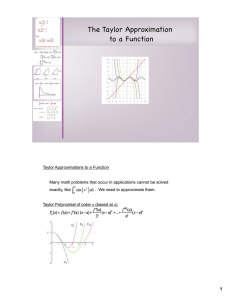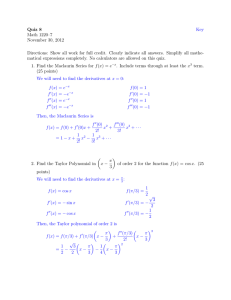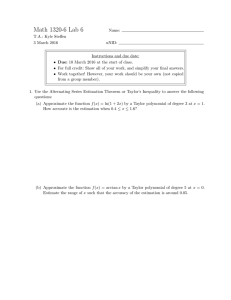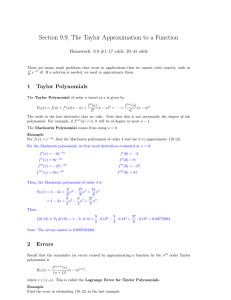Taylor Series Error 2
advertisement
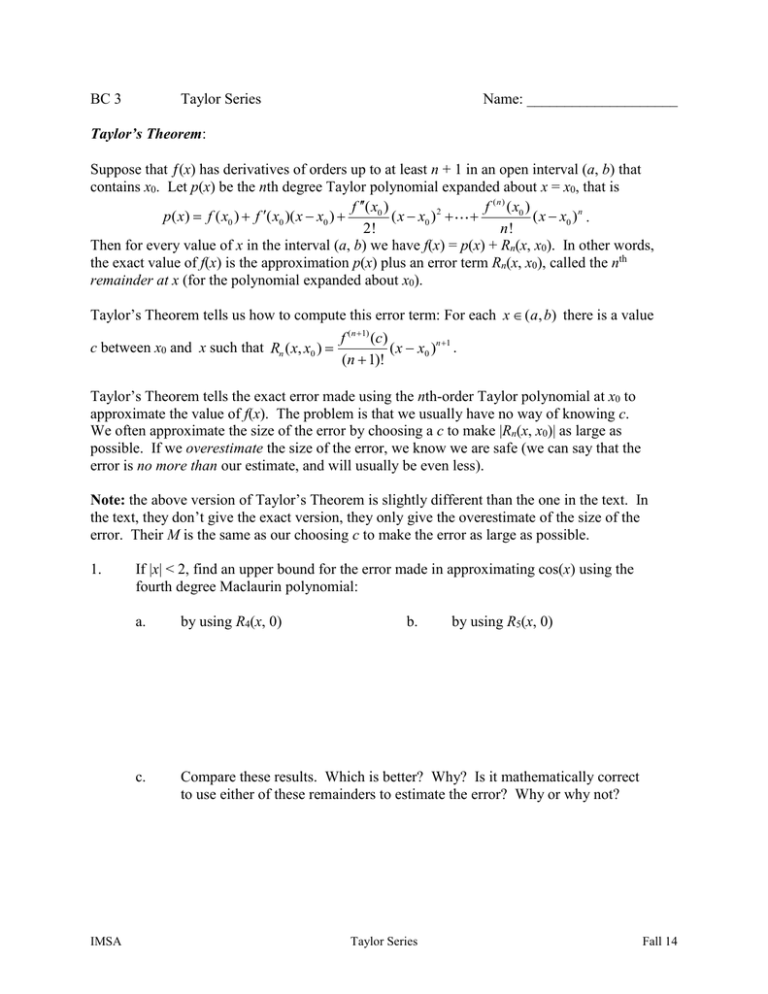
BC 3 Taylor Series Name: ____________________ Taylor’s Theorem: Suppose that (x) has derivatives of orders up to at least n + 1 in an open interval (a, b) that contains x0. Let p(x) be the nth degree Taylor polynomial expanded about x = x0, that is f ( x0 ) f ( n ) ( x0 ) 2 p( x) f ( x0 ) f ( x0 )( x x0 ) ( x x0 ) ( x x0 ) n . 2! n! Then for every value of x in the interval (a, b) we have f(x) = p(x) + Rn(x, x0). In other words, the exact value of f(x) is the approximation p(x) plus an error term Rn(x, x0), called the nth remainder at x (for the polynomial expanded about x0). Taylor’s Theorem tells us how to compute this error term: For each x ( a , b) there is a value f (n1) (c) c between x0 and x such that Rn (x, x0 ) (x x0 )n1 . (n 1)! Taylor’s Theorem tells the exact error made using the nth-order Taylor polynomial at x0 to approximate the value of f(x). The problem is that we usually have no way of knowing c. We often approximate the size of the error by choosing a c to make |Rn(x, x0)| as large as possible. If we overestimate the size of the error, we know we are safe (we can say that the error is no more than our estimate, and will usually be even less). Note: the above version of Taylor’s Theorem is slightly different than the one in the text. In the text, they don’t give the exact version, they only give the overestimate of the size of the error. Their M is the same as our choosing c to make the error as large as possible. 1. IMSA If |x| < 2, find an upper bound for the error made in approximating cos(x) using the fourth degree Maclaurin polynomial: a. by using R4(x, 0) b. c. Compare these results. Which is better? Why? Is it mathematically correct to use either of these remainders to estimate the error? Why or why not? Taylor Series by using R5(x, 0) Fall 14 2. IMSA For each of the following, the ex key on your calculator is on the blink. You will need to use the facts that 0 < e < 3 and e2 < 9 to answer the following. a. Find an upper bound for the error made in approximating e2 using the terms through n = 8 in the Maclaurin polynomial for ex. b. If we assume |x| < 1, what are the possible values for x if we want (the size of) the error in approximating ex using the quadratic Maclaurin polynomial to be less than 0.05? c. When approximating e, how many terms of the Maclaurin polynomial do you have to use in order to have an error that is less than 0.0001? d. Find an upper bound for the error made in approximating e9/10 using the terms through n = 6 in the Maclaurin polynomial. e. When approximating e3/2, how many terms of the Maclaurin polynomial do you have to use in order to have an error that is less than 0.00005? Taylor Series Fall 14
